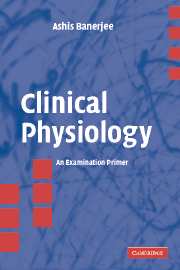11 - Gastrointestinal Physiology
Published online by Cambridge University Press: 05 June 2016
Summary
Introduction
The function of the gastrointestinal tract depends on the coordination and integration of secretory activity, motility and epithelial transport in order to allow the digestion of food with subsequent absorption of nutrients, minerals, vitamins and electrolytes.
Saliva
Saliva is produced by three paired major salivary glands, and minor salivary glands in the lip and palate:
Parotid glands: serous, enzyme-rich saliva;
Sublingual and submandibular glands: mixed serous and mucous saliva;
Minor salivary glands: mucin-rich saliva.
The rate of production is around 550 ml per day. Over 99% of saliva is constituted by water. Less than 1% consists of solids. Saliva is characterised by low osmolality and a high potassium concentration.
Functions of saliva
Moistens and lubricates food in preparation for swallowing.
Helps in food bolus formation.
Solubilises dry food, facilitating taste.
Aids speech.
Antimicrobial actions comprise the body's first barrier against infection:
lysozyme, lactoferrin, lactoperoxidases, mucin, secretory IgA. Saliva helps to control the bacterial counts of the oral cavity.
Digestive actions: contains alpha-amylase, initiating the digestion of starch.
Cleanses the mouth mechanically of food debris and cellular and bacterial remnants.
Buffering activity: saliva contains bicarbonate, protein and phosphate buffer systems. This helps neutralise refluxed gastric material in the oesophagus.
A non-irritating oral pH is maintained in spite of daily exposure to acidic influences.
Secretion of saliva
Saliva can be considered as an ultrafiltrate of plasma. This fact has allowed the use of saliva as a medium for the diagnostic testing of levels of ethanol, drugs of abuse and other substances.
Afferent input to stimulate secretion may arise from chemoreceptors in taste buds on the tongue, mechanoreceptors in periodontal ligament, and the sight and smell of food.
The efferent pathway involves the auriculotemporal nerve, which conveys parasympathetic fibres via the otic ganglion to the parotid gland, and the chorda tympani nerve, which supplies the submandibular and sublingual glands.
Swallowing
The process of swallowing is initiated voluntarily and followed by the swallowing reflex. It comprises the following phases:
Oral phase
The food is chewed, mixed with saliva and formed into a bolus; a rounded, smooth, lubricated portion of food. The tongue facilitates formation, containment and propulsion of the bolus backward and upward into the pharynx.
- Type
- Chapter
- Information
- Clinical PhysiologyAn Examination Primer, pp. 316 - 348Publisher: Cambridge University PressPrint publication year: 2005



